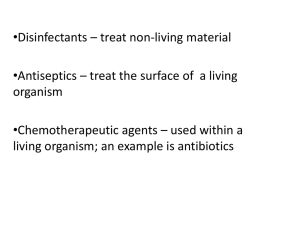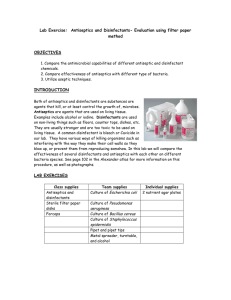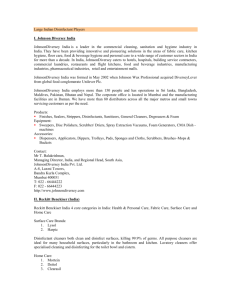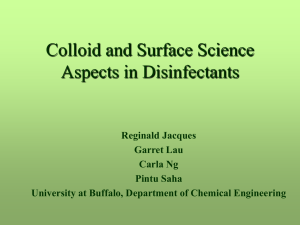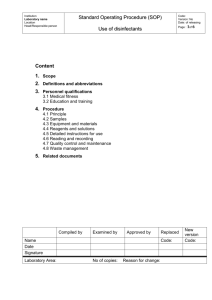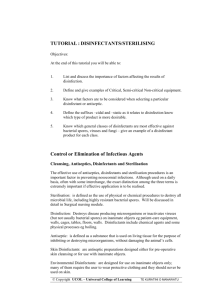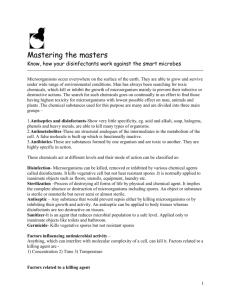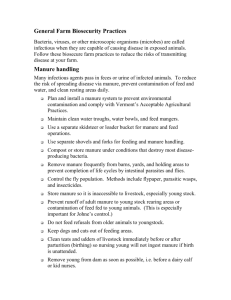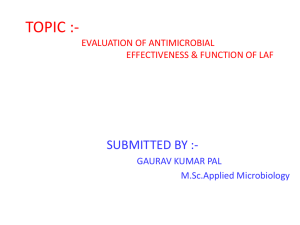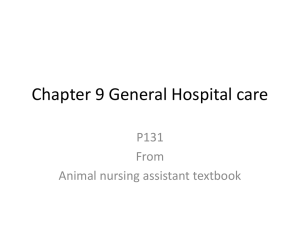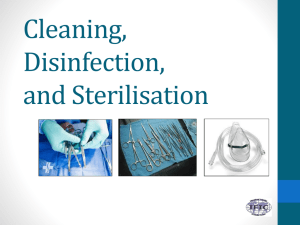CONTROL OF MICROBIAL GROWTH
advertisement
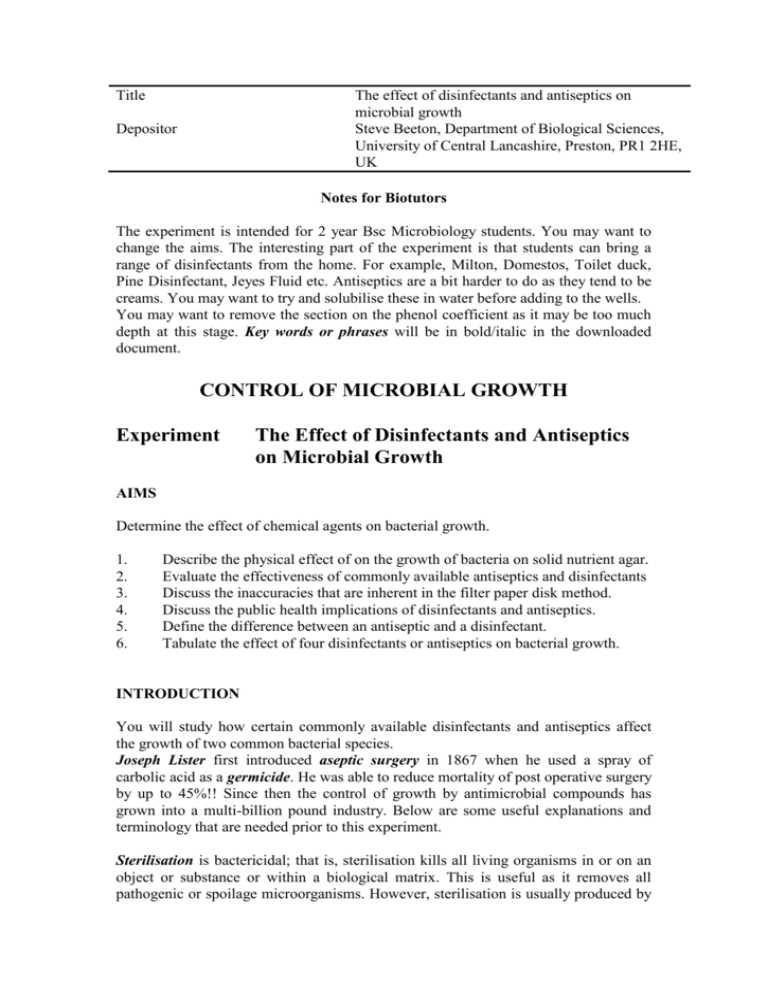
Title The effect of disinfectants and antiseptics on microbial growth Steve Beeton, Department of Biological Sciences, University of Central Lancashire, Preston, PR1 2HE, UK Depositor Notes for Biotutors The experiment is intended for 2 year Bsc Microbiology students. You may want to change the aims. The interesting part of the experiment is that students can bring a range of disinfectants from the home. For example, Milton, Domestos, Toilet duck, Pine Disinfectant, Jeyes Fluid etc. Antiseptics are a bit harder to do as they tend to be creams. You may want to try and solubilise these in water before adding to the wells. You may want to remove the section on the phenol coefficient as it may be too much depth at this stage. Key words or phrases will be in bold/italic in the downloaded document. CONTROL OF MICROBIAL GROWTH Experiment The Effect of Disinfectants and Antiseptics on Microbial Growth AIMS Determine the effect of chemical agents on bacterial growth. 1. 2. 3. 4. 5. 6. Describe the physical effect of on the growth of bacteria on solid nutrient agar. Evaluate the effectiveness of commonly available antiseptics and disinfectants Discuss the inaccuracies that are inherent in the filter paper disk method. Discuss the public health implications of disinfectants and antiseptics. Define the difference between an antiseptic and a disinfectant. Tabulate the effect of four disinfectants or antiseptics on bacterial growth. INTRODUCTION You will study how certain commonly available disinfectants and antiseptics affect the growth of two common bacterial species. Joseph Lister first introduced aseptic surgery in 1867 when he used a spray of carbolic acid as a germicide. He was able to reduce mortality of post operative surgery by up to 45%!! Since then the control of growth by antimicrobial compounds has grown into a multi-billion pound industry. Below are some useful explanations and terminology that are needed prior to this experiment. Sterilisation is bactericidal; that is, sterilisation kills all living organisms in or on an object or substance or within a biological matrix. This is useful as it removes all pathogenic or spoilage microorganisms. However, sterilisation is usually produced by autoclaving with the use of high temperatures and pressures. These temperatures and pressures can preclude the sterilisation of heat sensitive substances (us for example!) and objects that are too large to fit into autoclaves. Therefore, chemical sterilisation by disinfection or antisepsis at room temperature is often necessary. Disinfectants are described as antimicrobial agents used on inanimate objects such as instruments (medical or dental), plastics or structural surfaces (kitchen surfaces, toilets, washbasins etc.). If a disinfectant frees an object of all infectious agents, then sterilisation has occurred. The term antiseptic is applied to antimicrobial agents that are used on living tissue such as skin and throat mucosa. The majority of disinfectants are too toxic to use on humans as they are not selective in their antimicrobial action. Are disinfectants and antiseptics sterilising agents? Disinfectants and antiseptics do not always sterilise because these compounds usually do not kill all fungal and bacterial spores and vegetative bacteria and fungi. Organic compounds can interfere with their action reducing the efficiency of the antimicrobial agent. Here are a few of the many types of disinfectants: Phenolic compounds 1. Concentrated cresol ( for protecting outdoor wood) 2. Diluted and saponified (Lysol, used in microbiology to disinfect contaminated benches, glassware)) Alcohols (up to 70%) 1. Ethyl ( Hospitals) 2. Isopropyl ( Good for work surfaces) Synthetic detergents = QAC (quaternary ammonium compound) 1. Roccal 2. Zephiran Sterilising gases 1. Formaldehyde 2. Ethylene oxide mixtures (Carboxide, Cryoxide) No single disinfectant is ideal. Each has its advantages and disadvantages. For example, phenols sterilise well but are corrosive and toxic. Detergents and 70% alcohol have some microbiocidal effect but are not sporicidal and dry out skin surfaces. This practical will enable you to study some commonly available antiseptics and disinfectants and assess their efficiency against two common bacteria that can be isolated from kitchens, hospitals and from me and you. METHOD Non-quantitative Demonstration of Antibiosis 1. 2. 3. 4. 5. 6. 7. 8. 9. 10. 11. 12. Using a sterile swab dipped into the broth culture of Escherichia coli, inoculate the surface of one nutrient agar plate heavily to obtain confluent growth after incubation. Do the same with the other agar plate, using the broth culture of Staphylococcus aureus and a second sterile swab. Label the bottom of each plate with the name of the organism. Number the four antiseptic or disinfectant bottles that you will be testing 1, 2, 3, and 4. On the bottom of the agar plates, mark four sectors using a marker pen. Label the sectors 1, 2, 3, and 4. These numbered sectors correspond to the numbers you put on the antiseptic or disinfectant containers. Sterilise the tip of your forceps by passing it through the flame of your Bunsen burner two or three times. Aseptically pick up a sterile filter paper disk with your sterile forceps and dip the disk into the disinfectant or antiseptic numbered 1. Be sure that the excess disinfectant has drained off. Place the disk in the centre of Sector 1 of the S. aureus-inoculated plate. Using the same disinfectant, place another disk in Sector 1 of the E. coliinoculated plate. You are comparing the effectiveness of each disinfectant or antiseptic on both organisms. Repeat steps 8 and 9, placing the other disinfectants in the other sectors. Gently press the disks down with the tip of your flamed forceps to ensure contact with the nutrient agar. When all four disinfectant-soaked disks have been placed in all four sectors of both plates, seal them with parafilm, invert the plates and incubate them at 37oC for 48 hours. In your next laboratory session, observe, measure, and compare the zone of no growth (inhibition), if any, around the disk for each disinfectant or antiseptic for both organisms. Record the diameters (in millimetres) of the zones of inhibition a table . Include a short conclusion evaluating the effectiveness of the disinfectants or antiseptics that you have used. Do not be disappointed if your favourite antiseptics or disinfectants do not appear to be as bactericidal as advertised. The amount of disinfectant (or antiseptic) that the filter paper disk will absorb and the amount of diffusion into the medium surrounding the disk are dependent on the molecular weight of the disinfectant. The rate of diffusion is directly proportional to molecular size. So do not discard, for example, your favourite mouthwash on the basis of this activity. Answer the following questions True or False 1. 2. 3. 4. 5. 6. 7. 8. 9. 10. Disinfectants always remove all bacteria and fungal spores from an object. Antiseptic is another term for disinfectant. The presence of blood serum, skin tissue and other body fluids would interfere with the antimicrobial action of disinfectants. Disinfectants are used as mouth/throat gargles. The use of carbolic acid as a germicide in an operating room provided the beginning of aseptic surgery. Confluent growth is a thick growth of bacteria ( a bacterial lawn) over the entire surface of the medium. The zone of inhibition is the clear zone around an antimicrobial agent in which no bacteria are growing. All disinfectants are equally effective against most microbes. Cutting instruments, thermometers, and plastic materials are best sterilised by autoclaving. Louis Pasteur first introduced aseptic surgery by using a disinfectant. ____________________________________________________________________ MATERIALS . four disinfectants or antiseptics (bring from home or work) overnight broth cultures of: Escherichia coli Staphylococcus aureus sterile cotton swabs (2)* sterile nutrient agar plates (x2) sterile filter paper disks (paper punch tailings) ____________________________________________________________________ Useful references on the internet Lister and antiseptics-http://web.ukonline.co.uk/b.gardner/Lister.html E. coli-http://vm.cfsan.fda.gov/~mow/chap14.html S. aureus-http://www.niaid.nih.gov/dmid/staph.htm
